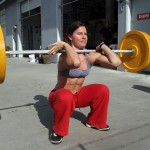Welcome back for the final part of this series on your metabolism …
How do I know if my metabolism has increased?
We all know why we want a reconditioned and faster metabolism – but how do you know if your metabolism is increasing?
But how do you know if your metabolism has been raised?
A raised metabolic rate will cause some physiological changes which indicate that your metabolism has been increased:
- Greater energy levels:A reconditioned and faster metabolism means that your body is able to more quickly release calories as fuel. This means that your energy systems are running more efficiently and you just have more ‘Get up & Go’ and are able do more. You’ll even find yourself looking forward to working out as it remains challenging but you have the reserves to do more and get more out of it.
- Temperature sensitivity alters: For most of us an increase in metabolism means that we produce more heat from our bodies and as a consequence feel the cold less. If you are one of those folk who rarely feel cold you may find that you are feeling hotter more often. You will also find that you break out into a sweat easier when you exercise as your body more quickly heats up and that you tend to sweat more as your body sheds heat. This is a good thing – it means you are burning calories!!
- Hormone Levels alter: You can get tested to find out for sure but the research shows that as your metabolism reconditions & speeds up you will experience a change in your hormone profile. Your energy highs & lows will smooth out meaning Insulin is under more control, you’ll feel les hungry meaning Leptin & Ghrelin are playing their roles better and you’ll be adding lean muscle, recovering faster, getting stronger and experiencing a higher libido – all of which means your testosterone levels have increased and likely your cortisol levels have dropped.
- Lower Resting Heart rate: This sounds counter to everything we’ve looked at about RMR – but a low resting heart rate is a sign of fitness, and disease aside the fitter & leaner you are the lower your heart rate. Now ‘low’ is an individual thing. My resting heart rate is 56 – not bad for a 50+ year old with a history of smoking, obesity and little exercise for way too many years!! Generally a resting rate of over 80 is unfit, and lower than 60 is good. However judge it after your 30 days based on where you started – if it was 90 and you’ve done your Lose 20 in 30 Program and it is now 79 that is a significant improvement.
(NB: anytime the body needs to speed up recovery, your heart rate is usually speeded up for some time. So your resting heart rate can be higher on occasion when you have had a particularly challenging session the day before. This is because your body will be in rebuild / recovery mode and increases in heart rate are a part of this as your body removes wastes created by tissue breakdown and also strives to deliver nutrients & other tissue building compounds.)
- Exercises get easier: Another sign of an increased metabolism is how much more you can lift / run / do before feeling fatigued. This is increased fitness and increased levels of fitness mean a reconditioned metabolism.
- You eat a huge meal and feel full for less time: Whilst you should NOT be eating to bursting at any meal, occasionally we all do and you will find with your new reconditioned, faster metabolism that your body deals with the excess food more quickly and reduces the tendency to bloat. The reason is the body is digesting the food quickly by activating more digestive enzymes so it can rapidly break down the essential nutrients to speed up muscular recovery. Of course if you are eating as the Lose 20 in 30 Program suggests then this will not be an issue for you.
The more of the above signs you experience, the more likely it is that you have reconditioned and increased your metabolism. Of course the other real sign is that your clothes are fitting better and you are seeing changes to your body shape & appearance in the mirror. The best sign of an increased metabolism is less bodyfat.
Take Away: Signs of increased Metabolism will vary from person to person, but the changes in your appearance and the way your clothes fit are the most visible ones.
Conclusion:
Well there you have it – a good grounding in what metabolism is what affects it and how you can manipulate it to reach your goal of becoming leaner and healthier.















